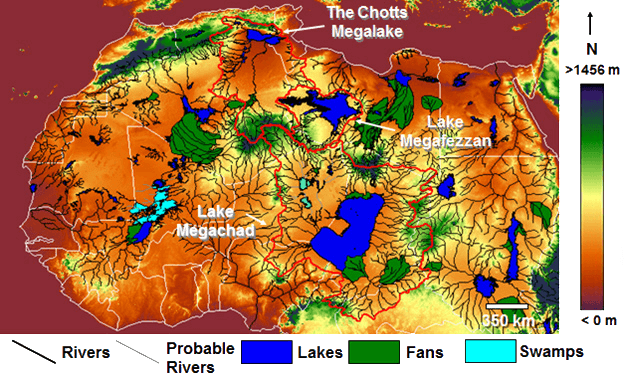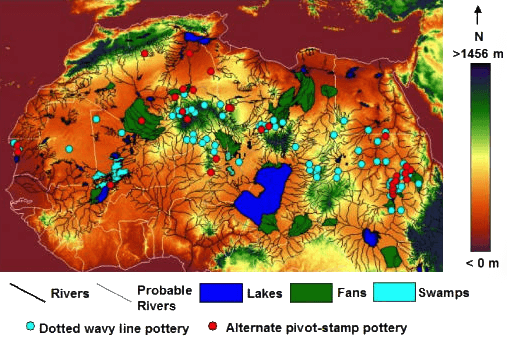Cultures > Paleolithic Egypt
Paleolithic Egypt

Background
It is known that humans have long existed in Africa for many hundreds of thousands of years throughout the Pleistocene epoch as the Aterian tool-making industry was influencing the Egyptian region around 40,000 years ago. Another tool industry that developed during this time period was the Khormusan industry that developed between 40,000 and 30,000 years ago. These advanced humans created tools from stone, bone and hematite. The stone arrow heads they created greatly resemble those found in the Americas but no bows have been excavated.
The earliest human skeleton recovered from the Egyptian region was known as the Nazlet Khater skeleton and was found in 1980. It was dated to be approximately 35,100 - 30,360 years ago and is the only complete modern human skeleton that has been recovered from the Paleolithic epoch in Africa. The Khormusan industry appears to disappear around 16,000 BCE with the introduction of the Gemaian industry among other cultures.

Sahara Desert Megalakes - Drake et al. 2015
However, modern science has been finding more and more evidence to suggest this was actually the case. The Nile River never used to run from south to north from Lake Victoria but instead ran from east to west across the Sahara Desert. Overall the entire paleoclimate of Earth was drastically different than what we see now and this sheds great light on where more Cultures would have developed.
This also has great implications for the Out of Africa hypothesis as most researchers believe the path taken was up from the Nile River. But if the Nile River did not exist in this capacity we need to examine human migration in terms of the climate that did exist during the Last Glacial Maximum and the end of the last Ice Age.

Sahara Lake and Rivers Map - Drake el at. 2015
Researchers have discovered plentiful amounts of ancient fish bones that suggest there was once a massive lake, rivers and other streams in the upper Sahara. During wetter periods fish and other aquatic life swam all throughout upper Africa and this may have happened before in history. There have also been excavated many species of animals that simply do not fit in a desert ecosystem, and give support for the idea of a green Sahara and possibly even other parts of Africa.
The presence of pottery during this period suggests that most civilization may not have been as nomadic as historians and archaeologists would have originally had us believe. All around the ancient lakes and river beds of the green Sahara there has been both wavy line and pivot-stamped pottery found which is indicative of very early industries. Pottery would not easy to carry around if all of the ancient humans at this time were nomadic and this looks more like ancient settlements set up along the ancient waterways.
Cultures
- Achaemenid Empire
- Aethiopia
- African Cultures
- Akkadian Empire
- Amarna Period Of Egypt
- Amratian Culture
- Amurru
- Antiu
- Arabic Islamic Egypt
- Archaic Period Of Egypt
- Assyria
- Aterian Industry
- Babylonia
- Badrian Culture
- Bronze Age Egypt
- Canaan
- Ceylon
- China
- Denyen
- Early Bronze Age
- Egypt
- Elam
- Faiyum A Culture
- Garamantes
- Gerzeh Culture
- Greco Roman Egypt
- Greece
- Hadhramaut
- Hittites
- Hyksos
- Kehek
- Khormusan Industry
- Kingdom Of Israel
- Kingdom Of Judah
- Kingdom Of Kush
- Kush
- Late Bronze Age Collapse
- Late Bronze Age
- Libu
- Libya
- Lower Egypt
- Maadi Culture
- Mechta Afalou
- Merimde Culture
- Meshwesh
- Mesopotamia And Egypt
- Middle Bronze Age
- Mitanni
- Naqada III
- Naqada Culture
- Neo Assyrian Empire
- Neolithic Revolution
- Nine Bows
- Niya
- Nubia
- Numidia
- Paleolithic Egypt
- Phoenicia
- Pre Dynastic Period Of Egypt
- Prehistoric Egypt
- Ptolemaic Kingdom
- Punt
- Roman Empire
- Sea Peoples
- Sebilian
- Sumer
- Tasian Culture
- Tenerian Culture
- Thinite Confederacy
- Upper Egypt
